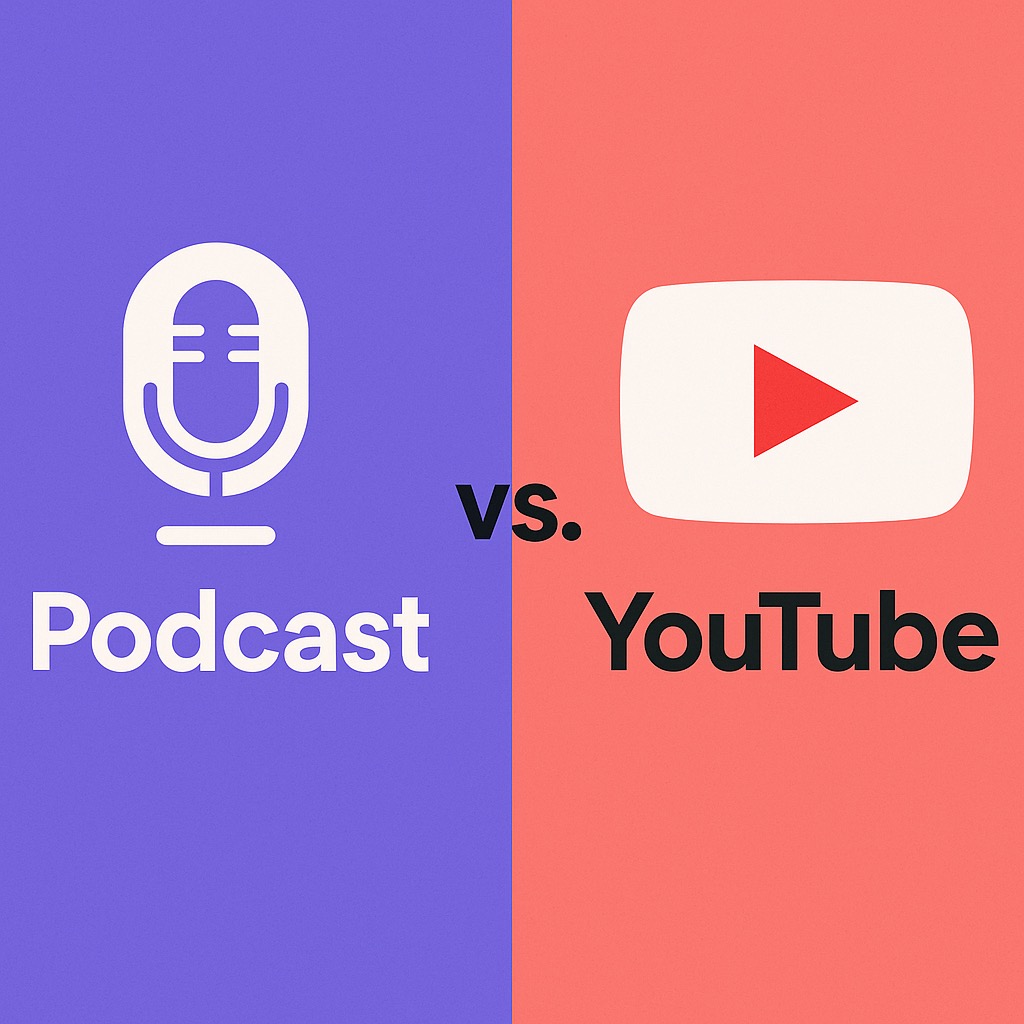Podcast vs YouTube

It’s the modern-day creator’s dilemma: should you speak or should you be seen? Do you invest in a microphone or a camera? Which platform will reach more people? Where’s the real money?
Here’s the truth: you don’t have to choose. The savviest creators today use both podcasts and YouTube to build an audience, deepen relationships, and maximize monetization.
This guide explores the pros and cons of each, shows you how to decide where to start, and reveals how to combine both into a powerhouse content strategy.
🎙️ Podcasting
Podcasts are audio-first shows that create a sense of intimacy. Listeners tune in while driving, working out, or doing chores, making podcasts a staple for busy, multitasking audiences.
Pros of Podcasting
-
Intimate & Loyal: Voice builds trust, fostering long-term community.
-
Convenient: Listeners consume while multitasking.
-
Niche Strength: Great for specialized topics and deep dives.
-
Monetization Paths: Sponsorships, ads, subscriptions, premium episodes.
Cons of Podcasting
-
Slower Growth: Takes consistency and time.
-
Discoverability Gaps: Less searchable than video.
-
Editing Needs: Basic audio production skills required.
Best For: Storytellers, interviewers, educators, and niche experts.
📹 YouTube
YouTube is the king of video and the second-largest search engine in the world. It’s where people discover tutorials, reviews, entertainment, and personalities.
Pros of YouTube
-
Massive Reach: Billions of active users.
-
SEO Friendly: Ranks in both YouTube and Google search.
-
Visual Engagement: Perfect for demos, vlogs, or tutorials.
-
Multiple Revenue Streams: Ads, sponsorships, memberships, merch, SuperChats.
Cons of YouTube
-
Production Heavy: Cameras, lighting, and editing can be resource-intensive.
-
Fierce Competition: Standing out requires strategy.
-
Time-Consuming: Filming and editing take effort.
Best For: Tutorials, reviews, entertainment, visual storytelling, and personality-driven content.
⚖️ Quick Comparison
| Feature | Podcasting 🎙️ | YouTube 📹 |
|---|---|---|
| Format | Audio-only | Video-first |
| Audience Size | Smaller, niche | Massive, global |
| Engagement | Deep, loyal | Broad, fast |
| Production | Easier, cheaper | More complex |
| Discoverability | Lower | Higher (SEO boost) |
| Monetization | Ads, sponsors, subs | Ads, sponsors, merch, fan funding |
🎧 Podcasting on YouTube: The New Hybrid
Here’s the twist: you can do your podcasting on YouTube. In fact, YouTube now supports podcast playlists and surfaces shows inside YouTube Music, expanding your reach beyond video.
Benefits of podcasting on YouTube:
-
Built-in discoverability via search and recommendations.
-
Ability to add video (even simple webcam footage) for more engagement.
-
Monetization through YouTube’s Partner Program once you qualify.
-
Distribution in YouTube Music for audio-focused listeners.
But the trade-offs:
-
You’ll miss Apple Podcasts, Spotify, and other dedicated apps if you’re YouTube-only.
-
Podcast purists often prefer RSS-based apps and background listening.
-
Analytics are video-first, so you’ll lose some traditional podcasting metrics.
👉 The sweet spot? Host your podcast traditionally (Buzzsprout, Podbean, etc.) for RSS distribution and upload episodes (or clips) to YouTube for growth.
🔄 How to Conquer Both Worlds
The most successful creators don’t choose between podcasting and YouTube—they combine them.
-
Repurpose Content: Record once, distribute twice. Film your podcast session → upload to YouTube → strip audio for podcast apps.
-
Cross-Promote: Mention your podcast on YouTube and vice versa. Use links in descriptions and show notes.
-
Clip Strategy: Post short highlights or clips on YouTube Shorts to capture new viewers.
-
Community Building: Use YouTube comments & live chats + podcast Q&As for a full engagement loop.
-
Monetization Mix: Blend podcast sponsorships with YouTube ads, memberships, and affiliate links.
📝 Blogging: Your Content Home Base
While YouTube and podcasts are distribution channels, your blog is owned real estate—a place you control.
-
SEO Boost: Blog posts rank in search, pulling in new listeners/viewers.
-
Repurpose Easily: Publish transcripts, detailed guides, or companion posts.
-
Monetize Directly: Affiliate links, digital products, courses, memberships.
-
Email Growth: Capture subscribers to promote both your podcast and YouTube.
❓ Common Questions About Podcasting on YouTube
Do I need video to publish my podcast on YouTube?
No. You can use static images or waveforms. Video helps engagement, but it’s optional.
Will I miss listeners if I only use YouTube?
Yes. Many dedicated podcast fans use Apple, Spotify, or other apps exclusively.
Can I monetize my podcast on YouTube?
Yes—ads, sponsorships, memberships, merch, and live streaming features.
Should I upload full episodes or just clips?
Do both. Full episodes build loyalty; clips drive discoverability.
Is YouTube replacing podcast apps?
Not yet. YouTube is leaning into podcasts, but Apple Podcasts and Spotify remain dominant.
🚀 Conclusion: Your Content, Your Way
The old “podcast vs YouTube” debate is outdated. The real opportunity is in combining them:
-
Start with your strengths (audio or video).
-
Repurpose across platforms for maximum reach.
-
Use your blog as the anchor to tie it all together.
Your voice deserves to be heard—and seen. Don’t limit yourself. Embrace both, experiment, and create the content ecosystem that works for you.